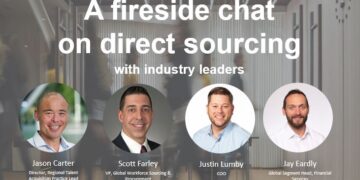Key takeaways from a peer roundtable: Influencing the C-suite
In today’s complex business world, C-suite leaders make long-term, strategic decisions after consulting experts within their organisations and networks. This group of people may include contributors, decision-makers, and influencers. In a post-pandemic world of work, talent decisions are taking priority in these C-suite conversations.

Beatrice Kohler, Midmarket Business Lead of Pontoon’s European Operations
For Procurement and HR teams leading contingent buying decisions, many are learning to navigate and influence the C-suite before moving forward with their multi-year, large-scale talent solution programmes.
I recently had the opportunity to discuss this topic with industry leaders at SIA’s CWS Summit Europe. Our conversation on the “Influencing the C-suite” covered every facet, from identifying the right “C” to education and informative knowledge sharing. Below are my key takeaways from our discussion.
1. Be the expert.
C-suite execs are met with competing priorities, board-level expectations and ever-expanding remits. With many strategic initiatives to review, they have limited time to develop a deep knowledge of various talent strategies. As the contingent workforce expert, whether in Procurement or HR, you possess the knowledge needed to guide conversations about supplemental workforces.
Contingent workforce management programmes are designed around an optimal experience for candidates and hiring managers plus efficiencies in process, speed to hire and cost savings. Highlighting these tangible benefits will help lead conversations that inform and educate the C-suite.
2. Appeal to each C-suite decision-maker.
To catch the attention of the C-suite, it is best to align with their targeted business objectives. Talent solutions and conversations can then be tailored to match each executive’s priorities, goals, and current pain points.
While a contingent workforce programme may solve for cost savings, compliance, and talent shortages across the entire organisation, you may successfully influence one C-suite member based on compliance alone. Asking the right questions to discover business challenges will often help delineate which leaders will benefit from a managed contingent workforce program.
Many procurement professionals may assume that the Chief Procurement Officer (CPO) will be the key figure in sponsoring their initiative. However, by understanding the key goals of each C-suite stakeholder and the company’s decision-making culture, programmes can be designed to fit each specific need and scaled through the organisation.
3. Demonstrate the value beyond risk avoidance.
Contingent workforce management is often viewed as a mechanism to avoid adverse events. One roundtable participant said they’re perceived value was simply, “avoid risk, avoid high cost, and avoid supplier problems”. With that view, it’s an uphill challenge to be seen as a partner versus a procurement tool.
Through proven use cases, process optimisation and hiring manager experience feedback, we can change the narrative of the impact and perceived value delivered by managed service programmes. Beyond the hiring manager and candidate experience, it’s important to highlight the far-reaching ecosystem that supports a workforce solution and specifically the strategic partnerships delivered by the supplier base.
Demonstrating the value of a programme may include workforce planning and candidate attraction schemes that will elevate the importance of MSPs and impact an entire organisation’s success.
In an outcome-focused solution, we have the opportunity to create value beyond tactical operations and to be positioned as strategic partners to the C-suite. Though impactful workforce delivery and retention of key talent, contingent workforce programmes become a value-add function that proactively influences business decisions.
Proposing and implementing a successful contingent workforce programme takes C-suite support, buy-in, and sponsorship. With these tools and a strategic approach, organisations will be poised to attract and retain talent, stay ahead of talent market changes, and prepare for the new world of work.
Related Post
We partnered with TalentNet to host an informative discussion with workforce experts from around the industry. The panellists included Jason Carter, Director of Regional Talent Acquisition Practice Lead at ...
Similar Resources
Leveraging analytics to make business decisions is exactly what needs to happen 100% of the time. In this scenario, Andrew Johns takes a deeper look at how analytics can be applied to cost-saving efforts ...





